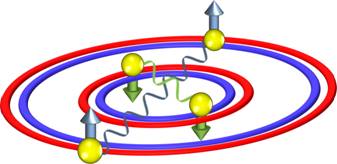A new form of superconductivity
Superconductors are remarkable materials which lose all electrical resistance when cooled below their “critical temperature”. In addition, the electrons in a superconducting material all act in unison, which is called “quantum coherence”. This leads to many special properties that are not displayed by ordinary matter, such as so-called “quantum levitation”. There are many applications of superconductors, of which perhaps the most familiar are the Magnetic Resonance Imaging (MRI) machines found in all major hospitals. More futuristic applications currently in advanced stage of development include levitating trains capable of speeds exceeding 600 km/h and ultra-fast super-computers.
Phase transitions in condensed matter physics generally correspond to the breaking of symmetries in the system and in superconductors, gauge symmetry is broken and electrons pair up to form Cooper pairs. In unconventional superconductors, such as the cuprate high temperature superconductors and heavy fermion superconductors, additional symmetries are often broken below the transition temperature. Usually, the Cooper pairs form in a singlet state, where the electrons have opposite spins, so that the Cooper pairs have zero spin overall. It is also possible, but much rarer for Cooper pairs to form in a triplet state with parallel spins. Due to the Pauli exclusion principle, which requires that the pairing wave function is antisymmetric upon exchanging the electrons, the singlet state has even parity and the triplet state has odd parity.
Time reversal symmetry breaking was recently observed in the superconductors LaNiC2 and LaNiGa2. In these materials, the spontaneous appearance of magnetic fields below the superconducting transition was detected using muon-spin relaxation. This behaviour is not expected for conventional superconductors, where the Cooper pairs are non-magnetic and the superconducting state is antagonistic to magnetism. Both LaNiC2 and LaNiGa2 have an orthorhombic crystal structure, where the structure of LaNiC2 is non-centrosymmetric, while LaNiGa2 is centrosymmetric. A theoretical analysis demonstrated that time reversal symmetry breaking necessarily implies non-unitary triplet pairing in both materials. On the other hand, other measurements seem to suggest that the superconducting energy gap of LaNiC2 is fully open, much like conventional s-wave superconductors, whereas unconventional superconductors often have a gap which goes to zero for electrons travelling along certain directions. These results appeared to be incompatible with the time reversal symmetry breaking, non-unitary triplet states allowed by the crystal symmetry.

To resolve this puzzle, scientists from Zhejiang University, Kent University, Bristol University and MPI-CPfS, led by Prof. Huiqiu Yuan from Zhejiang University, systematically studied the order parameters of the two compounds using various experimental techniques, such as measurements of the penetration depth, specific heat and transport properties at temperatures down to 50mK. They found that LaNiC2 and LaNiGa2 show strong evidence for two-gap superconductivity. These important findings allowed them to propose a new theoretical scenario which reconciles the non-unitary triplet state with a fully open gap. In their model (see the figure), the Cooper pairs form in a non-unitary triplet state between electrons of the same spin but on different orbitals. Instead of the Cooper pairs forming a state with odd parity as is typically expected for triplet pairing, the state has even parity but the Pauli exclusion principle is satisfied by the wave function being antisymmetric upon exchanging electrons between different orbitals. They showed that this model can lead to the presence of two fully open gaps, but unlike the usual two-gap superconductivity, in this instance one gap corresponds to Cooper pairs with spin-up electrons, the other to spin-down electrons.
These important results were published in Physical Review Letters on July 7th 2016 and the article was selected as an Editors’ Suggestion. According to Editors’ description, a highlighted Letter has additional significance, because only about one Letter in six is highlighted as a suggestion due to its particular importance, innovation, and broad appeal. The earlier work on the gap structure of LaNiC2 was published in New J. Phys.15 053005 (2013). These findings suggest that LaNiC2 and LaNiGa2 represent a class of novel superconductors and will stimulate further investigations. In addition, the identification of such a novel superconducting state may aid the discovery and characterization of new unconventional superconductors.
The full energy gap in these type of materials may make them usable in applications whereas the Cooper pairs of other unconventional superconductors are more sensitive, for example when the atoms in the material are disordered. In addition, the combination of quantum coherence and magnetism in the same system may offer new opportunities in areas such as information processing.
This work was financially supported by the National Natural Science Foundation of China, the Science Challenge Program of China, the National Basic Research Program of China and the Max Planck Partner Group.
Article Links:
1. Z. F. Weng, J. L. Zhang, M. Smidman, T. Shang, J. Quintanilla, J. F. Annett, M. Nicklas, G. M. Pang, L. Jiao, W. B. Jiang, Y. Chen, F. Steglich and H. Q. Yuan, Two-gap superconductivity in LaNiGa2 with nonunitary triplet pairing and even parity gap symmetry, Phys. Rev. Lett., 117, 027001 (2016). (Editors’ Suggestion).
DOI: http://dx.doi.org/10.1103/PhysRevLett.117.027001
2. J. Chen, L. Jiao, J. L. Zhang, Y. Chen, L. Yang, M. Nicklas, F. Steglich and H. Q. Yuan, Evidence for two-gap superconductivity in the non-centrosymmetric compound LaNiC2, New J. Phys. 15, 053005 (2013).
DOI: http://iopscience.iop.org/article/10.1088/1367-2630/15/5/053005
Contact:
Prof. Huiqiu Yuan (袁辉球)
Executive Deputy Director, Center for Correlated Matter
Zhejiang University
Tel/Fax: +86 571 88981363
Email: hqyuan@zju.edu.cn
URL: http://ccm.zju.edu.cn



